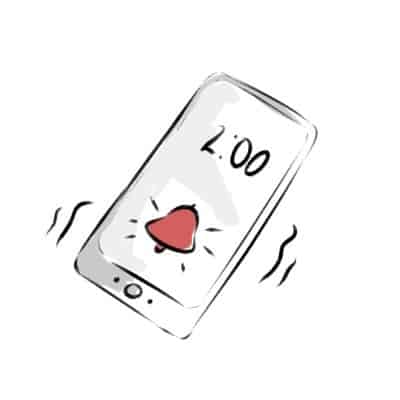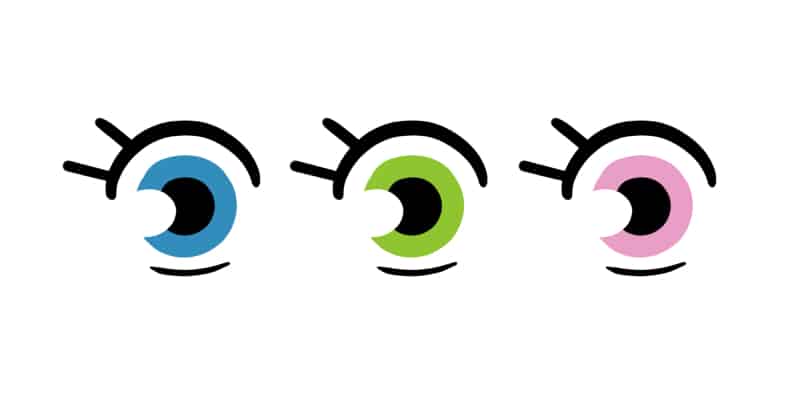One of the best ways to improve your art when getting used to a tablet is by doing drawing tablet exercises.
Not only will you develop great hand-eye coordination, but everything related to your art and drawings will improve as well.
So here are the best drawing tablet exercises to improve quickly, ranked from easiest to hardest!
Table Of Contents
Draw A Full Page Of Simple Shapes

This is one of the best exercises when you want to get used to your drawing tablet and to improve your lines!
I’ve recommended this kind of exercise before, but I really think it’s perfect.
It’s really simple, just open a document, any size you want. Then pick a brush and start drawing shapes.
Start with the most basic ones:
- Squares
- Triangles
- Rectangles
Draw them in different sizes and positions.
Now that you’re warmed up, go for something a bit more complex: circles!
Circles are known to be an artist’s nightmare. But that’s only true until you draw them enough and start being more confident in them.
So what better than filling a whole canvas with circles?

When you’re tired of those, you can then go for more complex shapes: draw some hexagons, pentagons, or even trapezoids!
You really can’t go wrong with this exercise.
It will help your muscle memory so that when you’re drawing other things in the future, you already know what shapes to use and how to draw them confidently.
But it will also improve your line work and your precision.
And, don’t forget, be sure to do some hand stretches before and after your practice time, so you don’t hurt yourself.
Draw A Line From Thin To Wide

One thing that people tend to struggle a bit at first on a drawing tablet is the pen pressure. Depending on how hard you press the pen on your tablet, the width of the line will be different!
This is especially hard if you’re more used to pencils and pen nibs than to brushes.
Even though you can set your stylus to different levels of sensitivity, it’s something that it’s good to practice.
So do just that! Draw several lines with different levels of width. Start very lightly, so you create a thin line and add pressure as you go.
Play with your pen pressure settings, and try different line widths.

This way, you’ll get more used to that feeling. And more than that, this is also an opportunity to figure out how you like your lines!
Is your style leaning more toward thin line art? Maybe thick black lines is the way to go.
Or even a mix of both!
This is a very simple exercise and, once again, a great warm-up! Just open up a new canvas on your drawing software of choice. Start by drawing a line lightly and then slowly increase the pressure.
Do this several times. Finally, after testing out different things, fill up another page, but this time see if you can make all the lines similar to each other.
Draw Matching Lines

Since we’re on a roll, why not continue our line exercises? This one is a bit more complex, but it’s a great exercise to have more control over your lines.
Draw a straight line, vertical or horizontal. It can be as long as you want!
Now draw a parallel line right beneath it.
Repeat this process until you fill the whole canvas, while always keeping the same distance between the lines!
Keeping the same distance and drawing lines similar to each other might be difficult at first. But through muscle memory, you’ll quickly improve at it.
As you go, you can also change the type of lines you draw. After some straight lines, try out the same exercise, but with curves. And what about a zig-zag line?
Be creative with these exercises.
Use Different Brushes To Draw The Same Thing

This one is especially good if you’re starting digital art!
When opening a drawing software, you’ll notice that you’ll have lots of choices regarding brushes.
There are just so many to choose from. Nowadays, you have brushes for everything.
Pen brushes, airbrushes, brushes that simulate traditional mediums like oil, watercolors, pastel, graphite, pencils, and so many others.
You’ll probably only use a few that you really like.
Personally, I used maybe a total of 3 brushes, since I like to keep things very simple.
However, you need to go through that process of first knowing what exists, trying them out, and then deciding what fits your style and your process.
Do you prefer flatter illustrations or something full of texture? Depending on the answer, the types of brushes you’ll use will be very different!
Not only that, but you might also find something new that you actually really enjoy by doing this exercise.
Remember that as you grow as an artist, certain preferences will change.
A big part of drawing is experimentation, so do have fun with that and you’ll see that you’ll learn something new with it!
Draw A Symmetrical Shape

Do you have some trouble drawing that second eye? Or keeping one side of the face similar to the other?
Then this is the perfect exercise!
It’s really hard to mirror things perfectly. In fact, unless you really copy and paste it, it’s always going to be a bit different.
But sometimes that difference is so minimal it’s hard to notice. And that’s really fine!
Personally, I think it’s good to show some asymmetry, it feels more human.
However, I do understand that at the beginning it’s a struggle to keep things relatively symmetric without making a mess.

So open a new document, any size will do, just choose something you’re comfortable with. Now, draw a vertical line in the middle of it.
Draw something on one side of it. It can be a very simple shape. There’s no need to start with very complex drawings.
Start with a square or a triangle, then go for a circle or a hexagon.
Now draw a symmetrical shape on the other side!
At first, this will be a bit hard, that’s why I recommend starting with simple shapes. But as you go, you’ll start feeling more comfortable with this exercise.
When that happens, go for more complex objects.
Go slowly and repeat each shape or object that you choose to draw more than once.
You’ll see that very soon, you’ll be able to draw that second eye with no problem!
Color A Drawing

This one is a bit more of a relaxing exercise. At least that’s how I feel about it.
But the truth is, colors and choosing them is harder than it seems.
Not only that but there are lots to learn about it.
So this is a great exercise where you just focus on color. Pick a drawing of yours or even some coloring pages online.
We do have a few of these on our Gumroad page, so you can grab some of these if you want!
Now, if you want you can pick your own colors. But I feel that this exercise works better by using specific palettes.
Go on Pinterest or Coolors and grab a random color palette that looks interesting to you.
Now, all you have to do is decide how to use each color on your drawing so that everything looks balanced and harmonious!
This is easier said than done, so I recommend using a random color palette.
Color palettes that you find online already use colors that will look good with each other. So it makes our job a bit easier!
If you’d like to dig deeper into Color Theory Click Here.
This way, in the future, when you need to pick your own colors, you have a better idea of what to go with.
Time-Limited Challenges
This one is great to both know your limits but also to learn what you can do if you have limited time.
I once made a Youtube video doing this kind of challenge and it was… interesting to say the least! And the first thing I learned with it is that I’m really not a fan of being timed.
The second thing I learned is that you need to learn what the most important features in a drawing are.
If you’re well aware of those, you can draw something in 10 seconds and the subject is still recognizable!
You can do this in two ways.
You can start with shorter timers and add more time for each drawing.
For example, start with 1 minute and draw something. For the next one set up a timer of 5 minutes. And so on.
I’d recommend not to go over 30 minutes. This is already enough time to have a very detailed drawing, but still being a bit of a challenge.

On the other hand, if starting with short-timers feels a bit too much for you right now, then do it the other around.
This is actually a very good exercise to practice gesture drawing! I’ve gone through much detail about it in another article on gesture drawing, but this is an exercise where you do very quick drawings of the human body.
Usually, these drawings take between 1 to 2 minutes.
This is just enough for you to capture the whole essence of the pose.
It’s not supposed to be detailed. What’s important is that you managed to capture the movement and flow of the pose itself.
This kind of exercise will also help you be looser with your drawings!
So if you want to do this challenge by doing some gesture drawing, I’d recommend using a figure drawing app like the Line of Action one.
On the other hand, if you want to draw random subjects, you can always try some drawing generator apps, so check those out!
3 Color Challenge
Similar to the previous one, but here instead of limiting time, we’re limiting the number of colors we’re using!
Again, you can use Coolors for this exercise. I really like using this website whenever I want to use random color palettes on my illustrations.
And you can actually limit the number of colors for each palette. So you can make it so you’ll only get 3 color palettes.
Generate a few and choose one that you like.
Now, to decide what to draw. For me, I always like to go with characters, so I try to come up with a character that fits those colors!
But I think it’s important or at least more entertaining to only choose what you’re going to draw once you have your colors.

This way, you’ll have to adapt your drawing to the colors and not vice versa!
You can start with 3 colors, like I did in this video, but if you want even more of a challenge, you can try 2 colors instead.
The fewer colors, the bigger the challenge is, but of course, you can use a few more. However, I do recommend not going over five colors.
When you limit the number of colors you use, you’re forced to really understand how well they work together.
Which of these colors should be your primary and most used one? How will you organize them, without having the same color side by side?
These are problems that you’ll have to solve and will make you a better artist in the long run!
What Drawing Tablet Should You Use For These Challenges?
Any drawing tablet will work for these challenges!
Doesn’t matter if it’s screened or not, or even if you’re using an iPad. Bigger or small, wired or wireless. Anything goes as long as it’s a comfortable table that fits your needs.
With that said, if you’re still unsure what drawing tablet to use, check my article on what’s the best size of drawing tablet for you (with recommendations).

Patricia Caldeira is the main writer here at Don Corgi. She's an art teacher with over 20.000 happy students across many platforms and courses!
Enjoy your stay and as always:
Keep on drawing!






